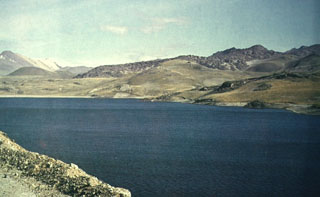Report on Laguna del Maule (Chile) — 22 December-28 December 2021
Smithsonian Institution / US Geological Survey
Weekly Volcanic Activity Report, 22 December-28 December 2021
Managing Editor: Sally Sennert.
Please cite this report as:
Global Volcanism Program, 2021. Report on Laguna del Maule (Chile) (Sennert, S, ed.). Weekly Volcanic Activity Report, 22 December-28 December 2021. Smithsonian Institution and US Geological Survey.
Laguna del Maule
Chile
36.058°S, 70.492°W; summit elev. 2162 m
All times are local (unless otherwise noted)
SERNAGEOMIN reported that inflation at Laguna del Maule continued in an area SW of the lake during 1-15 December, though deformation had been decreasing since October with a with a maximum rate of 1.88 centimeters per month. Deformation rates during November and December were comparable to those recorded prior to 2019. The number of volcano-tectonic events had also decreased; the largest event was a M 2.3 located 4.1 km ESE from the center of the lake at a depth of 6.1 km. The Alert Level for Laguna del Maule was lowered to Green, the lowest level on a four-color scale, on 24 December. ONEMI canceled the Yellow Alert for San Clemente, and reminded the public to stay 1 km away from the area producing anomalous carbon dioxide emissions, about 5 km SW of the lake’s shore.
Geological Summary. The Laguna del Maule volcanic complex includes a 15 x 25 km caldera with a cluster of small stratovolcanoes, lava domes, and pyroclastic cones of Pleistocene-to-Holocene age. The caldera lies mostly on the Chilean side of the border, but partially extends into Argentina. Fourteen Pleistocene basaltic lava flows were erupted down the upper part of the Maule river valley. A cluster of Pleistocene cinder cones was constructed on the NW side of Maule lake in the northern part of the caldera. The latest activity produced an explosion crater on the E side of the lake and a series of Holocene rhyolitic lava domes and blocky lava flows that surround it.
Sources: Servicio Nacional de Geología y Minería (SERNAGEOMIN), Oficina Nacional de Emergencia-Ministerio del Interior (ONEMI)

